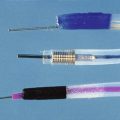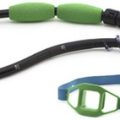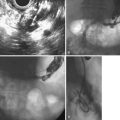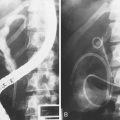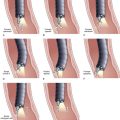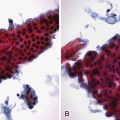Chapter 7 Sedation and Monitoring in Endoscopy
Introduction
Sedative and analgesic drugs are frequently used to facilitate endoscopic procedures. The principal aim of sedation is to maintain a cooperative patient so that the endoscopic procedure can be completed effectively and safely. The potential benefits of sedation can be realized in terms of patient satisfaction and the efficiency of the procedure. Sedation is associated with potential problems, however. Sedation-related complications have been implicated in more than 50% of all reported endoscopic complications and include aspiration, oversedation, hypoventilation, and airway obstruction.1,2 Sedation has time, cost, and staffing implications in terms of additional monitoring and recovery. With these issues in mind, there have been studies and expressed opinion in favor of unsedated endoscopy, with attempts at selecting tolerant patients (see Chapter 10).3–6 The practice of unsedated endoscopy varies greatly geographically and culturally; rates are particularly low in the United States.7
When using sedation, several factors may influence the class of sedative, the depth of sedation, and the necessary level of anesthetic expertise present during the procedure. These factors include the length and complexity of the procedure, the degree of discomfort expected or experienced, and patient comorbidity. Patients vary in their sensitivity to sedation and their tolerance of endoscopy. The level of sedation may be broadly considered on a spectrum from no sedation to general anesthesia (Table 7.1). The most frequently used level in endoscopic procedures is conscious sedation, whereby the patient is able to make purposeful responses to verbal or tactile stimuli and with ventilatory and cardiovascular functions maintained. This level of sedation is normally achieved with a benzodiazepine alone or combined with an opiate. There has been an increase in the use of deep sedation, most commonly with propofol.
| Level 1: Minimal sedation | Drug-induced state, during which patient responds normally to verbal commands. Cognitive function and coordination may be impaired. Ventilatory and cardiovascular function are unaffected |
| Level 2: Conscious sedation | Drug-induced depression of consciousness, during which patient responds purposefully to verbal commands, either alone or accompanied by light tactile stimulation. Patent airway is maintained without help. Spontaneous ventilation is adequate, and cardiovascular function is usually maintained |
| Level 3: Deep sedation | Drug-induced depression of consciousness, during which patient cannot be easily aroused but responds purposefully to repeated or painful stimulation. Patient may require assistance maintaining an airway. Spontaneous ventilation may be inadequate, and cardiovascular function is maintained |
| Level 4: General anesthesia | Patient is not able to be aroused even by painful stimuli. Patient often requires assistance in maintaining patent airway. Positive-pressure ventilation may be required owing to respiratory depression or neuromuscular blockade. Cardiovascular function may be impaired |
From Bryson HM, Fulton BR, Faulds D: Propofol: an update of its use in anesthesia and conscious sedation. Drugs 50:513–559, 1995.
Patient Evaluation and Preparation
Appropriate preprocedural evaluation of the patient’s history and physical findings reduces the risk of adverse outcomes (see Chapter 8).8 The clinicians responsible for sedation should familiarize themselves with specific and relevant aspects of the medical history, including abnormalities of major organ systems, previous adverse experience with sedation and analgesia, current medications and drug allergies, time of the last oral intake, and history of alcohol or recreational drug use. A thorough physical examination is required particularly to assess the heart and lungs in addition to the airway. It may be useful to consider the patient in terms of the American Society of Anesthesiologists (ASA) status classification (Table 7.2). There is usually no indication to perform laboratory tests, unless particular concern is raised during assessment.
Table 7.2 Definition of American Society of Anesthesiologists Status
| Class 1 | Patient has no organic, physiologic, biochemical, or psychiatric disturbance. Pathologic process for which operation is to be performed is localized and does not entail systemic disturbance |
| Class 2 | Mild to moderate systemic disturbance caused either by the condition to be treated surgically or by other pathophysiologic processes |
| Class 3 | Severe systemic disturbance or disease from whatever cause; it may be impossible to define degree of disability with finality |
| Class 4 | Severe systemic disorders that are already life-threatening, not always correctable by operation |
| Class 5 | Moribund patient who has little chance of survival but is submitted to operation in desperation |
Procedural Monitoring
Patients undergoing endoscopic procedures should have continuous monitoring before, during, and after the administration of sedatives.9 Monitoring should be discontinued only when the patient is fully awake. The literature and medical opinion suggest that continuous recording of the patient’s level of consciousness, respiratory function, and hemodynamics reduces the risk of sedation-related adverse outcomes.8 Early detection of adverse events induced by sedatives, such as hypoxemia and cardiovascular compromise, allows intervention to prevent life-threatening complications. Each of the parameters monitored is addressed.
Level of Consciousness
Decreasing level of consciousness is associated with loss of reflexes that normally protect the airway and prevent hypoventilation. The response of patients to commands during sedation serves as a guide to their level of consciousness (see Table 7.1). Spoken responses also provide an indication that the patient is breathing. During procedures in which verbal responses are impossible, such as upper gastrointestinal (GI) endoscopy, other responses should be sought, including hand movements or a nod of the head. Lack of response to verbal or tactile stimuli suggests a greater level of sedation and should be treated accordingly.
Pulmonary Ventilation
Respiratory depression is probably the central event in sedation-related complications, and monitoring of ventilatory function reduces the risk of adverse outcomes. Ventilatory function can be monitored by observation of respiratory movement or by direct pulmonary auscultation. If ventilatory function cannot be observed, transcutaneous carbon dioxide (CO2) and end-tidal CO2 can be measured by capnography. Capnography measures CO2 indirectly by light absorption in the infrared region of the electromagnetic spectrum. If a patient’s ventilation is compromised, CO2 retention occurs, which is identified as an early event on capnography often before oxygen desaturation.10 Unless the breathing system is a closed circuit, the exact measurement of CO2 is inaccurate. The presence of a CO2 trace on capnography is reassuring that the patient is still breathing, however. Alternatively, respiratory activity can be continuously measured graphically using expired air CO2 detectors.11 This method can detect the early phases of respiratory depression. No studies have addressed whether capnography improves outcome in patients with conscious sedation.
Pulse Oximetry
Various probes are available; however, the most commonly used probe is a reusable one for use on fingers or toes. Pulse oximetry in sedated patients has been shown to improve assessment of respiratory status.12 The routine use of pulse oximetry in unsedated endoscopy is not always indicated, however.13 Although oximetry is not a substitute for monitoring ventilatory function, hypoxemia is more likely to be detected using oximetry in addition to clinical assessment. Pulse oximeter probes occasionally detect peripheral oxygen saturation poorly, however, resulting in a falsely low or absent oxygen saturation reading. Failure rates have been shown to be 7%,14 although the accepted error is 3% when compared with arterial blood gases.15 Failure is more common in patients who are ASA class 3 and higher, patients with hypertension or hypotension, patients with hypothermia, patients with pigmented skin, elderly patients, and patients with renal failure. Pulse oximeters require adequate pulsations to distinguish arterial blood light absorption from venous blood and tissue light absorption. The reading may be unreliable or absent if there is loss or diminution of the peripheral pulse; this may occur with blood pressure cuff inflation, improper positioning, hypothermia, hypotension, and peripheral vascular disease. Although the response time of the pulse oximeter is fast, there may be a significant delay in the alveolar oxygen tension and change in oximeter reading.16
Hemodynamic Measurements
Sedative agents and analgesics may have mild direct effects on hemodynamic control, such as hypotension and cardiovascular response to stress. These changes can be detected by regular measurement of pulse and blood pressure. Changes in blood pressure and pulse may represent responses to hypoxemia, oversedation, or possibly patient distress to procedure-induced pain. Although no evidence shows that blood pressure monitoring during endoscopy influences morbidity and mortality, it has been suggested that both regular blood pressure measurements and pulse be measured throughout procedures performed under sedation.17 There is wide geographic variation in this practice, however. Continuous electrocardiogram (ECG) monitoring should be considered in high-risk patients, such as patients with disturbances in cardiac rhythm or ischemic heart disease. The necessity for ECG monitoring has not been shown in clinical trials.
Supplemental Oxygen
Oxygen given via nasal cannulas or via a mask has been shown to reduce oxygen desaturation during endoscopy performed under sedation18,19 and should be given to all patients receiving sedation. However, because supplemental oxygen delays the onset of hypoxemia in sedated patients who are hypoventilating, it is important not to rely solely on oximetry to monitor ventilation but to employ additional techniques, including assessment of respiratory rate.
Sedation and Consent
There are two issues surrounding consent and sedation. The first is that the patient should be fully informed of the indications, risks, and alternatives to sedation. The second is whether the patient while under sedation is able to withdraw consent. If a sedated patient indicates during endoscopy that he or she wishes the procedure to be terminated, should the clinician complete the procedure or stop, given it may be in the patient’s best interests to complete it? In a study, 88% of colonoscopists stated that they would stop only after repeated requests by the sedated patient, and only 45% of colonoscopists thought patients were capable of making rational decisions while under sedation.20 From the patient’s perspective, opinion is evenly divided into terminating the examination immediately or completing.
Staffing Levels and Training
Specific areas of concern include the potentiation of sedative-induced respiratory depression by concomitantly administered opioids and benzodiazepines and inadequate time intervals between doses of sedatives. Individuals monitoring sedated patients should be able to recognize complications associated with the sedative drugs. Given that most complications associated with sedatives are cardiopulmonary, at least one individual should be familiar with advanced airway and ventilation management. Failing this, guidelines recommend an advanced resuscitation provider be immediately available in the event of an emergency.8 Resuscitation equipment must be readily available and should include a cardiac defibrillator, advanced airway and positive-pressure ventilation equipment, and all the appropriate drugs including sedative antagonists (Box 7.1).8
Box 7.1
Appropriate Emergency Equipment to Have Available When Using Sedative or Analgesic Drugs Capable of Causing Cardiorespiratory Depression
From Practice guidelines for sedation and analgesia by non-anesthesiologists: A report by the American Society of Anesthesiologists Task Force on sedation and analgesia by non-anesthesiologists. Anesthesiology 84:459–471, 1996.
Postprocedural Monitoring
 Patients should be given written instructions regarding the signs and symptoms of any adverse outcomes of the procedure and contact numbers for 24-hour advice.
Patients should be given written instructions regarding the signs and symptoms of any adverse outcomes of the procedure and contact numbers for 24-hour advice.In a placebo-controlled study, the benzodiazepine antagonist flumazenil was shown to enhance recovery from sedation and amnesia without any risk of resedation.21 Use of flumazenil increases the expense of the procedure, but it may be preferable to patients. Use of flumazenil does not preclude the need for postprocedural monitoring, and the advantages of routine use may be negligible and are as yet unproven.
Drugs for Sedation
Characteristics of an ideal sedative agent include the following:
The most commonly used drugs are benzodiazepines used alone or in combination with an opiate. It is vital that clinicians become familiar with some specific sedatives (e.g., either pethidine or fentanyl). More recently, propofol has been used as an agent to induce deep sedation. The benzodiazepines midazolam and diazepam are frequently used and have been found to have similar efficacy.22,23 Midazolam is a more attractive agent because of its rapid onset of action, short half-life, and amnestic properties. Fentanyl, meperidine, and pethidine are the most commonly used opiates, with fentanyl preferred because of its rapid action and absence of nausea.
A combination of a benzodiazepine and an opiate is frequently used in endoscopy, although this may lead to a greater incidence of sedation-related complications.24 In colonoscopy, opiates combined with benzodiazepines are frequently used, but their combined use has not been shown to be more efficacious than benzodiazepines alone. Combination therapy in colonoscopy and upper GI endoscopy does not seem to improve pain and tolerance compared with individual agents.24–26 The literature generally suggests that administration of intravenous sedatives or analgesics is achieved safely by giving small incremental doses until the desired level of sedation is attained, rather than giving a single dose based on patient weight. The drug should be titrated with sufficient time elapsed between doses to allow for the full effect of each dose to be assessed before subsequent drug administration. Although not based on evidence, it has been suggested that opiate drugs are administered before benzodiazepines to titrate the latter carefully because of their greater sedative effects.
Droperidol has been used in the sedation of agitated patients. However, it is associated with hypotension and a prolonged recovery period. The U.S. Food and Drug Administration (FDA) has issued a warning following droperidol-induced cardiac arrhythmias. Nitrous oxide has been used as a form of patient-controlled analgesia in several studies involving colonoscopy.27,28 Potential benefits include an absence of sedation-related risks and a rapid recovery. In terms of patient tolerance, the studies were inconsistent showing no or reduced benefit compared with traditional sedation.
Propofol and Deep Sedation
Propofol is increasingly used for GI endoscopy because of its rapid onset, rapid recovery, and attainable depth of sedation. Propofol is an anesthetic agent with a rapid onset of action, amnestic properties, and a very short context-sensitive half-life of 2 to 8 minutes, rendering it an attractive agent for endoscopic procedures. Patients who regularly use sedatives and narcotics are often insensitive to standard benzodiazepine sedation and may benefit from propofol sedation. There are disadvantages associated with propofol use, however. Because of its short context-sensitive half-life, propofol must be continuously titrated to maintain sedation. The narrow therapeutic window between conscious sedation, deep sedation, and anesthesia necessitates close monitoring. Compared with midazolam, the amnestic properties of propofol are inferior.29 As a result of peripheral vasodilation and impairment of cardiac contractility, propofol may cause profound hypotension. Propofol causes apnea more readily than midazolam, so managing the airway and breathing is more critical if propofol is used.
Propofol Use in Standard Endoscopic Procedures
Propofol has been compared with midazolam in several trials during standard endoscopic procedures.30,31 Although the results are inconsistent, propofol seems to improve patient cooperation and reduces recovery time. There does not seem to be any consistent difference in patient tolerance or safety. Because propofol has no analgesic properties, its use in combination with fentanyl has been investigated and compared with standard benzodiazepine and narcotic combinations.32,33 The results were inconsistent in terms of sedation, analgesia, recovery, and incidence of side effects, suggesting propofol confers no additional benefit over standard sedation regimens.
Propofol Use in Complex Endoscopic Procedures
The use of propofol in complex and prolonged procedures has also been investigated. In a randomized trial, Wehrmann and colleagues34 compared propofol with midazolam for ERCP and found patient cooperation to be superior and recovery times to be less in the propofol group; however, patient tolerance was the same. A patient in the propofol group required ventilatory support. The benefit of propofol over midazolam was replicated in two other studies for ERCP with endoscopic ultrasound and ERCP with sphincter of Oddi manometry.35,36
Nurse-Administered Propofol Sedation
Given the narrow therapeutic window and potential for cardiopulmonary adverse events, many endoscopists favor the expertise of an anesthetist to administer and monitor propofol sedation. Using an anesthetist incurs additional costs, which offsets any cost advantage gained by a more rapid sedation induction and recovery time. There is growing evidence, however, to support the practice of nurse-administered propofol sedation (NAPS). In a study involving a series of 9152 patients given NAPS under the supervision of an endoscopist, NAPS was found to be safe and effective. The nurses were trained and registered to administer and monitor propofol sedation and were not nurse anesthetists. There were seven cases of respiratory compromise (three prolonged apnea, three laryngospasm, one aspiration) associated with upper endoscopy, which required mask ventilation only. The greater frequency of respiratory adverse events with upper endoscopy is probably related to the deeper level of sedation required to prevent reflex gagging. The ideal procedures for administration of NAPS are lower endoscopic procedures, in which adverse complications are particularly low. The colonic perforation rate was less than 1 : 1000, and patients preferred NAPS over previous experiences with benzodiazepines.37 In a randomized study comparing NAPS and nurse-administered midazolam for colonoscopy, time to sedation was more rapid with propofol, recovery was faster, and patient satisfaction was improved.33 NAPS is also cost-effective compared with anesthetist-administered propofol.35
Propofol Patient-Controlled Analgesia
Patient-controlled analgesia and sedation (PCS) with propofol has been assessed in several studies. PCS using propofol and alfentanil was compared with diazepam (Diazemuls) and pethidine given as a bolus during colonoscopy in 66 randomly assigned patients. PCS provided lighter sedation, less analgesia, faster recovery, with similar patient satisfaction.38 In a more recent study, Kulling and associates39 compared PCS using propofol and alfentanil, continuous infusion, or NAPS and found PCS to exhibit a higher degree of patient satisfaction with faster recovery. Similar results were generated when comparing propofol PCS with midazolam.40
Propofol and Patient Monitoring
Patients receiving propofol for procedures probably require more monitoring than patients undergoing conscious sedation, although there is as yet no evidence to support additional monitoring. Preprocedural assessment should include a full history of sedation-related risk factors and airway assessment. Risk factors include conditions such as age extremes, cardiopulmonary disease, hepatic or renal impairment, narcotic or sedative use, and a potentially difficult airway for intubation (Box 7.2). Trials of NAPS have selected only patients with ASA status class 1 or 2 for propofol.37 The ASA Task Force stated that if the patient has one or more sedation-related risk factors, coupled with the potential for deep sedation (with propofol), the incidence of adverse sedation-related events is likely to be high. In these circumstances, an anesthetist should be consulted before the procedure. Vargo and coworkers11 used capnography to guide propofol titration, allowing respiratory depression to be identified early, although this was not shown to have an impact on outcome.
Box 7.2 American Society of Anesthesiologists Task Force Situations Associated with Difficult Airway Intubation
Management of Oversedation
Sedatives have been implicated in more than 50% of all endoscopy-related complications; the most common adverse reactions are oversedation and respiratory depression. The expected mean desaturation during all sedated endoscopic procedures is about 3% from baseline.41 The availability of reversal agents for sedative drugs is associated with a decreased risk of sedation-related adverse events. The specific antagonists available include flumazenil for benzodiazepines and naloxone for opioids. No antagonists exist for propofol, although the short context-sensitive half-life lends to a rapid reversal of sedation when the infusion is ceased. The literature supports the use of flumazenil and naloxone individually to reverse benzodiazepine-induced and opioid-induced sedation and ventilatory depression. In patients who have received both a benzodiazepine and an opioid, flumazenil reverses sedation but not respiratory depression. Similarly, naloxone monotherapy has not been shown to reverse respiratory depression induced by opioid and benzodiazepine combinations. In the setting of combination therapy–induced respiratory depression, it is recommended that naloxone is given in addition to flumazenil. At the time of reversal or before reversal, the following should be done:
Flumazenil and naloxone previously were reserved for the treatment of oversedation and respiratory depression. However, prolonged recovery times associated with the use of benzodiazepines have prompted research into the feasibility of using flumazenil routinely to reduce recovery times with potential cost savings.21,42
Unsedated Endoscopy
Because of the risks and additional costs associated with the use of sedative drugs in endoscopy, unsedated endoscopy is increasingly being considered. In particular, the availability of ultrathin endoscopes (5 to 6 mm) has rendered unsedated endoscopy far more attractive. Several studies have shown comparable and improved tolerance using the ultrathin compared with standard endoscopes.43 The transnasal approach does not seem to be different from the peroral route.44,45 The benefits of unsedated endoscopy include a reduction in morbidity associated with sedative drugs, reduced patient monitoring, more rapid recovery, less time off work, and reduced cost. The potential disadvantages include poor patient satisfaction, with refusal to undergo repeat procedures; incomplete examination because of patient intolerance; and the inability to perform therapeutic procedures. The refusal rate for upper GI endoscopy remains high.46
Patient selection is of paramount importance before unsedated upper endoscopy. Several studies suggested older age, low anxiety scores, tolerance of pharyngeal anesthesia, and tolerance of prior endoscopy were associated with tolerance of unsedated upper endoscopy.47 The data regarding the benefit of pharyngeal anesthesia in unsedated endoscopy are inconsistent, although the larger studies suggest improvement in patient tolerance and ease of performance.48 Several studies have shown colonoscopy can be completed successfully without sedation in up to 95% of patients in one series.49,50 The refusal rate for unsedated colonoscopy can be 83%.51
Review of Specific Drugs
Benzodiazepines
Midazolam
Opioid Analgesics
Propofol
Precautions and Adverse Reactions
The most important effect to be monitored with propofol is respiratory depression and apnea, occurring frequently with deep sedation. Hypotension is also common. Patients with ASA class 3 or higher, elderly patients, and patients using sedatives or opioid agents are at particular high risk for developing these cardiorespiratory complications. Apnea and hypotension can occur in 75% of patients. In endoscopic trials using propofol, ventilatory support was necessary in 10% of patients, although incidence of respiratory depression necessitating support was far greater in complex procedures requiring a cooperative patient.34 Excitatory phenomena such as tremors, twitches, hypertonus, and hiccups can occur in 14%. Rarely, pulmonary edema, hypertension, cardiac arrhythmias, bronchospasm, and laryngospasm have occurred. Pain at the injection site is the most frequent local complication and occurs in 5% to 50% or more of patients.52
1 Freeman ML. Sedation and monitoring for gastrointestinal endoscopy. Gastrointest Endosc. 1994;4:475.
2 Benjamin SB. Complications of conscious sedation. Gastrointest Endosc Clin N Am. 1996;6:277.
3 Wang TH, Lin JT. Sedation for upper GI endoscopy in Taiwan. Gastrointest Endosc. 1999;50:888-889.
4 Shaker R. A wake up call? Unsedated versus conventional esophagogastroduodenoscopy. Gastroenterology. 1999;117:1492-1495.
5 Saeian K, Townsend WF, Rochling FA. Unsedated transnasal EGD: an alternative approach to conventional esophagogastroduodenoscopy for documenting Helicobacter pylori eradication. Gastrointest Endosc. 1999;49:297-301.
6 Sorbi D, Gostout CJ, Henry J, et al. Unsedated small-caliber esophagogastroduodenoscopy (EGD) versus conventional EGD: a comparative study. Gastroenterology. 1999;117:1301-1307.
7 Arrowsmith JB, Gerstman BB, Flescher DE, et al. Results from the American Society for Gastrointestinal Endoscopy/US Food and Drug Administration collaborative study on complication rates and drug use during gastrointestinal endoscopy. Gastrointest Endosc. 1991;37:421-427.
8 Practice guidelines for sedation and analgesia by non-anesthesiologists: A report by the American Society of Anesthesiologists Task Force on sedation and analgesia by non-anesthesiologists. Anesthesiology. 1996;84:459-471.
9 Simon IB, Lewis RJ, Satava RM. A safe method for sedating and monitoring patients for upper and lower gastrointestinal endoscopy. Am Surg. 1991;57:219-221.
10 Nelson DB, Freeman NL, Silvis SE, et al. A randomized controlled trial of transcutaneous carbon dioxide monitoring during ERCP. Gastrointest Endosc. 2000;51:288-295.
11 Vargo JJ, Zuccaro G, Dumot JA, et al. Gastroenterologist-administered propofol for therapeutic upper endoscopy with graphic assessment of respiratory activity: a case series. Gastrointest Endosc. 2000;52:250-255.
12 Council on Scientific Affairs, American Medical Association. The use of pulse oximetry during conscious sedation. JAMA. 1993;270:1463-1468.
13 Banks MR, Kumar PJ, Mulcalhy HE. Pulse oximetry saturation levels during routine unsedated diagnostic upper gastrointestinal endoscopy. Scand J Gastroenterol. 2001;36:105-109.
14 Moller JT, Pedersen T, Rasmussen LS, et al. Randomized evaluation of pulse oximetry in 20,802 patients. 1. Design, demography, pulse oximetry failure rate, and overall complication rate. Anesthesiology. 1993;78:436-444.
15 Alexander CM, Teller LE, Gross JB. Principles of pulse oximetry: theoretical and practical considerations. Anesth Analg. 1989;68:368-376.
16 Verhoeff F, Sykes MK. Delayed detection of hypoxic events by pulse oximeters: computer simulations. Anaesthesia. 1990;45:103-109.
17 Waring JP, Baron TH, Hirota WK, et al. Guidelines for conscious sedation and monitoring during gastrointestinal endoscopy. Gastrointest Endosc. 2003;58:317-322.
18 Griffin SM, Chung SCS, Leung JWC. Effect of intranasal oxygen on hypoxia and tachycardia during endoscopic cholangiopancreatography. BMJ. 1990;300:83-84.
19 Bell GD, Bown S, Morden A. Prevention of hypoxaemia during upper gastrointestinal endoscopy by means of oxygen via nasal cannulae. Lancet. 1987;1:1022-1024.
20 Ward B, Shah S, Kirwan P, et al. Issues of consent in colonoscopy: if a patient says ‘stop’ should we continue? J R Soc Med. 1999;92:132-133.
21 Chang AC, Solinger MA, Yang DT, et al. Impact of flumazenil on recovery after outpatient endoscopy: placebo-controlled trial. Gastrointest Endosc. 1999;49:573-579.
22 Brouillette DE, Leventhal R, Kumar S, et al. Midazolam versus diazepam for combined esophagogastroduodenoscopy and colonoscopy. Dig Dis Sci. 1989;34:1265-1271.
23 Bell GD, Morden A, Coady T, et al. A comparison of diazepam and midazolam as endoscopy premedication assessing changes in ventilation and oxygen saturation. Br J Clin Pharmacol. 1988;26:595-600.
24 Rembacken BJ, Axon AT. The role of pethidine in sedation for colonoscopy. Endoscopy. 1995;27:244-247.
25 Froehlich F, Thorens J, Schwizer W. Sedation and analgesia for colonoscopy: Patient tolerance, pain and cardiorespiratory parameters. Gastrointest Endosc. 1997;45:1-4.
26 Laluna L, Allen ML, Dimarino AJJr. The comparison of midazolam and topical lidocaine spray versus the combination of midazolam, meperidine, and topical lidocaine spray to sedate patients for upper endoscopy. Gastrointest Endosc. 2001;53:289-291.
27 Forbes GM, Collins BJ. Nitrous oxide for colonoscopy: a randomized controlled study. Gastrointest Endosc. 2000;51:271-277.
28 Saunders BP, Fukumoto M, Halligan S, et al. Patient-administered nitrous oxide/oxygen inhalation provides effective sedation and analgesia for colonoscopy. Gastrointest Endosc. 1994;40:418-421.
29 Smith I, Monk TG, White PF, et al. Propofol infusion during regional anesthesia: sedative, amnestic and anxiolytic properties. Anesth Analg. 1994;79:313-319.
30 Carlsson U, Grattidge P. Sedation for upper gastrointestinal endoscopy: a comparative study of propofol and midazolam. Endoscopy. 1995;27:240-243.
31 Patterson KW, Casey PB, Murray JP, et al. Propofol sedation for outpatient upper gastrointestinal endoscopy: comparison with midazolam. Br J Anaesth. 1992;68:108-111.
32 Koshy G, Nair S, Norkus EP, et al. Propofol versus midazolam and meperidine for conscious sedation in GI endoscopy. Am J Gastroenterol. 2000;95:1476-1479.
33 Sipe BW, Rex DK, Latinovich D, et al. Propofol versus midazolam/meperidine for outpatient colonoscopy: administration by nurses supervised by endoscopists. Gastrointest Endosc. 2002;55:815-825.
34 Wehrmann T, Kokabpick S, Lembcke B, et al. Efficacy and safety of intravenous propofol sedation during routine ERCP: a prospective controlled study. Gastrointest Endosc. 1999;49:677-683.
35 Vargo JJ, Zuccaro G, Dumot JA, et al. Gastroenterologist-administered propofol versus meperidine and midazolam for ERCP and EUS: a randomized, controlled trial with cost effectiveness analysis. Gastroenterology. 2002;123:8-16.
36 Seifert H, Schmitt TH, Gultekin T, et al. Sedation with propofol plus midazolam versus propofol alone for interventional endoscopic procedures: a prospective randomized study. Aliment Pharmacol Ther. 2000;14:1207-1214.
37 Walker JA, McIntyre RD, Schleinitz PF, et al. Nurse-administered propofol sedation without anesthesia specialists in 9152 endoscopic cases in an ambulatory surgery center. Am J Gastroenterol. 2003;98:1744-1750.
38 Roseveare C, Seavell C, Patel P, et al. Patient-controlled sedation and analgesia, using propofol and alfentanil, during colonoscopy: a prospective, randomized controlled trial. Endoscopy. 1998;30:768-773.
39 Kulling D, Fantin AC, Biro P, et al. Safer colonoscopy with patient-controlled analgesia and sedation with propofol and alfentanil. Gastrointest Endosc. 2001;54:1-7.
40 Ng JM, Kong CF, Nyam D. Patient-controlled sedation with propofol for colonoscopy. Gastrointest Endosc. 2001;54:8-13.
41 Berg JC, Miller R, Burkhalter E. Clinical value of pulse oximetry during routine diagnostic and therapeutic endoscopic procedures. Endoscopy. 1991;23:328-330.
42 Bartelsman JF, Sars PR, Tytgat GN. Flumazenil used for reversal of midazolam-induced sedation in endoscopy outpatients. Gastrointest Endosc. 1990;36:S9-S12.
43 Dean R, Dua K, Massey B. A comparative study of unsedated transnasal esophagogastroduodenoscopy and conventional EGD. Gastrointest Endosc. 1996;44:422-426.
44 Elfant AB, Schneider DM, Bourke MJ. Prospective controlled trial of transnasal endoscopy (T-EGD) vs per-oral endoscopy (P-EGD). Gastrointest Endosc. 1996;43:311.
45 Craig A, Hanlon J, Dent J, et al. A comparison of transnasal and transoral endoscopy with small-diameter endoscopes in unsedated patients. Gastrointest Endosc. 1999;49:292-296.
46 Zaman A, Hahn M, Hapke R. A randomized trial of peroral versus transnasal unsedated endoscopy using an ultrathin videoendoscope. Gastrointest Endosc. 1999;49:279-284.
47 Mulcahy HE, Kelly P, Banks MR, et al. Factors associated with tolerance to, and discomfort with, unsedated diagnostic gastroscopy. Scand J Gastroenterol. 2001;36:1352-1357.
48 Campo R, Brullet E, Montserrat A, et al. Topical pharyngeal anesthesia improves tolerance of upper gastrointestinal endoscopy: a randomized double-blind study. Endoscopy. 1995;27:659-664.
49 Rex DK, Imperiale TF, Portish V. Patients willing to try colonoscopy without sedation: associated clinical factors and results of a randomized controlled trial. Gastrointest Endosc. 1999;49:554.
50 Cataldo PA. Colonoscopy without sedation. Dis Colon Rectum. 1996;39:257.
51 Early DS, Saiffudin T, Johnson JC. Patient attitudes towards undergoing colonoscopy without sedation. Am J Gastroenterol. 1999;94:1862-1865.
52 Valtaren M, Lisalo E, Kanto J, et al. Propofol as an induction agent in children: pain on injection and pharmacokinetics. Acta Anaesthesiol Scand. 1989;33:152-155.













































